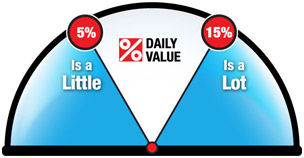Learning how to read food labels is like looking at a prescription for your health and your life. We recommend looking for red-flag ingredients- if a Hall of Blame ingredient is listed among the top five ingredients overall, steer clear!
Every packaged food made in Canada has a food label indicating serving size and other nutritional information. The “Nutrition Facts” food labels are intended to give you information about the specific packaged food in question. Measurements of fat, cholesterol, sodium, carbohydrate, protein, vitamins and minerals are calculated for a “typical portion.” But, reading these labels can be confusing. Below are some explanations of its components.
| Food Hall of Blame | Food Hall of Fame |
| 1. Sugar 2. High Fructose Corn Syrup 3. Enriched Wheat Flour (White Flour) 4. Saturated Fat 5. Hydrogenated Oil |
1. Olive Oil 2. Garlic 3. Tomato Sauce 4. Spinach 5. Raw Nuts 6. Pomegranates |
Serving Size
Serving sizes are based on the amount of food people typically eat, which makes them realistic and easy to compare to similar foods. This may or may not be the serving amount you normally eat. It is important that you pay attention to the serving size, including the number of servings in the package and compare it to how much you actually eat. The size of the serving on the food package influences all the nutrient amounts listed on the top part of the label. For example, if a package has 4 servings and you eat the entire package, you quadruple the calories, fat, etc. that you have eaten.
Calories and Calories from Fat
The number of calories and grams of nutrients are provided for the stated serving size. This is the part of the food label where you will find the amount of fat per serving.

Nutrients
This section lists the nutrients such as fat, cholesterol, sodium, potassium, carbohydrates, protein, vitamins and minerals. The amounts listed are according to the serving size on the food package. On the right hand side you will notice the percent of daily values. It is a guide to help you make informed food choices. It shows you if the serving size has a little or a lot of a nutrient: These daily values are the reference numbers based on current nutrition recommendations and are based on a 2000 calorie diet.
Ingredients
Each product should list the ingredients on the label. They are listed from largest to smallest amount (by weight). This means a food contains the largest amount of the first ingredient and the smallest amount of the last ingredient.
Label Claim. Another aspect of food labeling is label claims. Some food labels make claims such as “low cholesterol” or “low fat.” These claims can only be used if a food meets strict government definitions.
Hall of Blame
Sugar
When you eat or drink sugar the sudden energy surge your body experiences is followed by an insulin surge that rapidly drops the blood sugar level-so two hours later, you feel famished and tired. To keep an even keel, replace simple carbohydrates with complex ones so the absorption is more controlled and you experience long-term satiety. While sugar should be eaten, it should come together with fat or some element like fiber (as you would find in fruit) so you can absorb it a bit more slowly.
In a recent study done by the USDA, it was reported that the average American consumes 134 pounds of refined sugar every year, or approximately 20 teaspoons of sugar per day. As hard as this may be to believe, consider the following facts:
A 12 oz. can of Pepsi’ contains 10 teaspoons of sugar
A 2 oz. package of candy contains 11 teaspoons of sugar
A 16 oz. cup of lemonade contains 13 teaspoons of sugar
A cup of Frosted Flakes’ contains 4 teaspoons of sugar
This high level of sugar intake is very unhealthy and contributes to obesity, Type II diabetes, and heart disease due to elevated triglycerides, kidney stones, dental caries, chronic tiredness and reactive hypoglycemia. Decreasing your sugar intake is as simple as avoiding foods that are high in refined sugars, such as soft drinks, candy, cake and donuts, as well as most condiments. When you purchase sweetened food, look for products that are sweetened with apple juice or stevia, rather than sugar or high-fructose corn syrup.

Decreasing your sugar intake is as simple as avoiding foods that are high in refined sugars, such as soft drinks, candy, cake and donuts, as well as most condiments.
High Fructose Corn Syrup
Although they taste sweet food products that contain high fructose corn syrup should be avoided. The body processes the sugar in high-fructose corn syrup differently than it does old-fashioned cane or beet sugar, which in turn alters your body’s natural ability to regulate appetite. High fructose corn syrup blocks the ability of a chemical called leptin, which is the way your stomach tells your brain it’s full. It’s not so much the 150 calories in the soda pop, it’s the fact at that same meal you will normally consume an extra hundred calories of food than you normally would have.
Enriched Wheat Flour (White Flour)
Contrary to what its name suggests, enriched flour is actually poor in nutrition because most of the grain’s nutrients are destroyed in the refining process. The reason they enrich it is because they already stripped out anything that was nutritious, and they add a little bit back so it doesn’t look so bad.
Instead, look for whole grains and whole grain flours. Bread or baked products should read, “whole grain including the germ as one of the first ingredients.”
Saturated Fat
Found mainly in animal products; avoid saturated fats that are solid at room temperature, like lard. You can actually use this kind of material for furniture polish-lots of fun things-but don’t put it in you.
Hydrogenated Oil
To increase their shelf life, certain oils are hydrogenated. This process turns the oil into a solid at room temperature, but it also makes the oil unhealthy. This stuff is great because it doesn’t go bad, but it’s very bad for you. It is one of the number one causes of diseases of the heart.Avoid food products that contain hydrogenated oil or partially hydrogenated oil, often labeled as trans fats.
Hall of Frame
Healthy Oils
There are many healthy oils, such as olive oil, sesame seed oil, flaxseed oil, grape seed oil and canola oil. To maximize their health benefits good oils need to be used properly. Keep it in a dark bottle or in your refrigerator-that’s how to keep it healthy so it doesn’t go rancid. Healthy oils are delicate, you have to treat them delicately.
Overheating good oils during cooking can damage them. Don’t cook the oil, cook the food, which means put a tiny bit of oil in the pan, put the food in the oil and then put the food with the oil on it in the pan-that way the oil is preserved. It doesn’t heat up and it doesn’t get damaged by the heat.
Garlic
Garlic is great for our bodies. It actually helps the bacteria in your intestines and it also relaxes the arteries and it has a benefit with cancer. It’s a great thing to add to your diet. It’s present in a lot of cultures and makes food taste superb!
Salad dressing made with fresh garlic, lemon and olive oil is one of our favorites. It’s a perfect dressing, It’s the best way to have olive oil because you haven’t heated it and you haven’t damaged it.
Tomato Sauce
Eating 10 tablespoons of tomato sauce per week is a great health benefit. Inside the tomato is a chemical called lycopene. This chemical has a wonderful effect–it’s an antioxidant.
There are added benefits from eating tomato sauce or paste as opposed to plain tomatoes. A raw tomato is fine, too, but if you get a little fat with it-either with some nuts or a little olive oil and dressing-then it’s perfect. It helps you absorb it better into your intestinal system.
Spinach

Jam-packed with nutrients, spinach is out-of-sight. This is the best thing for your eyes, It’s better than carrots, and a lot of macular degeneration–which is a tragic ailment that affects vision–can actually be avoided by eating these kinds of foods that are rich in carotenoids and also have folic acids and a lot of other benefits. Sauté spinach with a little garlic and olive oil for a perfect side dish.
Raw Nuts
To maximize the benefits of the healthy oils found in nuts such as almonds, hazelnuts or walnuts they should be eaten raw and stored in the refrigerator. When you roast a nut, the healthy oils that are in there become damaged. The oils aren’t supposed to be heated and damaged-they’re supposed to be taken in their natural form.
Pomegranates
Research on the health benefits of pomegranates has shown promising results. We’ve done studies on them showing how they actually can change the way your arteries age-it’s a very potent antioxidant, It also probably affects cancer rates, especially prostate cancer, but those studies haven’t been finished yet.
Not only do pomegranates have extraordinary health benefits-they taste good, too.

